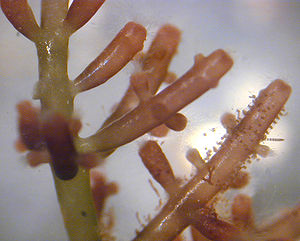홍조식물
홍조식물(紅藻植物; 문화어: 붉은마름식물) 또는 홍조류(紅藻類)는 조류로 분류되는 원생생물의 한 갈래로, 전 세계에 약 600속의 2,000종 정도가 알려져 있다. 모두 분홍색이나 암홍색 색소체를 가지며, 광합성 작용에 의해 홍조 녹말을 만든다. 대부분은 바다 속에서 자라지만, 이 밖에 민물이나 축축한 흙 표면에서 자라는 것도 있다. 한편, 몇 속의 단세포인 것을 제외하면 거의가 다세포로 이루어져 있으며, 크기는 수 mm에서 수십 mm에 이른다. 몸은 실·잎·나뭇가지 모양 또는 그물코 모양으로 된 것도 있다. 대부분 부드러운 것이 많으나, 산호말류처럼 세포벽 사이에 탄산칼슘이 축적되어 돌처럼 딱딱하게 된 무리도 있다.
|
| ||
|---|---|---|
 | ||
| 생물 분류ℹ️ | ||
| 역: | 진핵생물 | |
| (미분류): | 원시색소체생물 | |
| 문: | 홍조식물문(Rhodophyta) Wettstein, 1922 | |
| 강 | ||
| ||
특징
편집홍조식물의 공통적인 특징은 다음과 같다.
- 핵·엽록체·미토콘드리아·액포 등의 분화된 세포 기관을 가진다(진핵생물).
- 분홍색이나 암홍색 등의 엽록체를 가지는데, 여기에는 엽록소 a나 엽록소 d 및 홍조소와 남조소 등의 피코빌린 색소를 함유하고 있다.
- 광합성 결과 체내에 저장되는 동화 물질은 홍조 녹말이다.
- 유성 생식은 난자와 정자에 의한다.
- 생식 세포에는 편모가 없어서 헤엄을 칠 수가 없다.
김이나 풀가사리 무리처럼 얕은 바다에서 생육하는 것도 있지만, 대부분의 홍조식물은 간조선보다 더 깊은 곳에서 자란다. 특히, 우뭇가사리는 약 10m 정도의 깊은 곳에서 많이 자라며, 이 밖에 100m 이상의 깊은 곳에서 자라는 종류도 매우 많다. 홍조식물이 이렇게 깊은 곳에서 자랄 수 있는 것은 체내에 있는 홍조소가 약 0.5mμ 부근의 단파장 빛을 광합성에 이용하기 때문이다. 빛은 바다 수심이 깊어짐에 따라 적색·주황색·황색·자색·남색·녹색·청색의 순서로 흡수되므로, 가장 깊은 곳까지 도달될 수 있는 것은 청색과 녹색이다. 따라서, 홍조식물은 깊은 바다에 위치하면서 자신의 몸 빛깔과 보색 관계에 있는 청색이나 녹색빛을 광합성에 이용한다. 한편, 얕은 곳에서 자라는 진두말 등은 전체적으로 녹색을 띠므로, 홍조식물이 아니라고 생각되기도 하는데, 이것은 적색이나 황색의 장파장 빛을 광합성에 잘 이용한 결과 녹색 엽록소량은 늘어난 반면 홍조소는 감소된 보색 적응 현상 때문이다.
분류
편집전통적인 분류
편집- 홍조식물문(紅色植物門, Rhodophyta)
- 원시홍조강(原始紅藻綱, Bangiophyceae)
- 진정홍조강(眞正紅藻綱, Florideophyceae)
2004년 분류
편집- 식물계(Plantae)
- 홍조식물아계(Rhodoplantae)
- 키아니디움문(Cyanidiophyta)
- 키아니디움강(Cyanidiophyceae)
- 홍조식물문(Rhodophyta)
- 키아니디움문(Cyanidiophyta)
- 홍조식물아계(Rhodoplantae)
2006년 분류
편집계통 분류
편집다음은 원시색소체생물의 계통 분류이다.[1][2][3][4][5][6][7][8][9][10]
| 원시색소체생물 |
| ||||||||||||||||||||||||||||||||||||||||||||||||||||||
아래는 최근 제안된 홍조류의 계통 분류 중 하나이다.[11][12]
| 홍조식물문 |
| ||||||||||||||||||||||||||||||||||||
같이 보기
편집각주
편집- ↑ Leliaert, Frederik; Smith, David R.; Moreau, Hervé; Herron, Matthew D.; Verbruggen, Heroen; Delwiche, Charles F.; De Clerck, Olivier (2012). “Phylogeny and Molecular Evolution of the Green Algae” (PDF). 《Critical Reviews in Plant Sciences》 31: 1–46. doi:10.1080/07352689.2011.615705.
- ↑ Marin, Birger (2012). “Nested in the Chlorellales or Independent Class? Phylogeny and Classification of the Pedinophyceae (Viridiplantae) Revealed by Molecular Phylogenetic Analyses of Complete Nuclear and Plastid-encoded rRNA Operons”. 《Protist》 163 (5): 778–805. doi:10.1016/j.protis.2011.11.004. PMID 22192529.
- ↑ Laurin-Lemay, Simon; Brinkmann, Henner; Philippe, Hervé (2012). “Origin of land plants revisited in the light of sequence contamination and missing data”. 《Current Biology》 22 (15): R593–R594. doi:10.1016/j.cub.2012.06.013. PMID 22877776.
- ↑ Leliaert, Frederik; Tronholm, Ana; Lemieux, Claude; Turmel, Monique; DePriest, Michael S.; Bhattacharya, Debashish; Karol, Kenneth G.; Fredericq, Suzanne; Zechman, Frederick W. (2016년 5월 9일). “Chloroplast phylogenomic analyses reveal the deepest-branching lineage of the Chlorophyta, Palmophyllophyceae class. nov”. 《Scientific Reports》 (영어) 6: 25367. Bibcode:2016NatSR...625367L. doi:10.1038/srep25367. ISSN 2045-2322. PMC 4860620. PMID 27157793.
- ↑ Cook, Martha E.; Graham, Linda E. (2017). Archibald, John M.; Simpson, Alastair G. B.; Slamovits, Claudio H., 편집. 《Handbook of the Protists》 (영어). Springer International Publishing. 185–204쪽. doi:10.1007/978-3-319-28149-0_36. ISBN 9783319281476.
- ↑ Lewis, Louise A.; Richard M. McCourt (2004). “Green algae and the origin of land plants” (abstract). 《American Journal of Botany》 91 (10): 1535–1556. doi:10.3732/ajb.91.10.1535. PMID 21652308.
- ↑ Ruhfel, Brad R.; Gitzendanner, Matthew A.; Soltis, Pamela S.; Soltis, Douglas E.; Burleigh, J. Gordon (2014년 2월 17일). “From algae to angiosperms–inferring the phylogeny of green plants (Viridiplantae) from 360 plastid genomes”. 《BMC Evolutionary Biology》 14: 23. doi:10.1186/1471-2148-14-23. ISSN 1471-2148. PMC 3933183. PMID 24533922.
- ↑ Adl, Sina M.; Simpson, Alastair G. B.; Lane, Christopher E.; Lukeš, Julius; Bass, David; Bowser, Samuel S.; Brown, Matthew W.; Burki, Fabien; Dunthorn, Micah (2012년 9월 1일). “The Revised Classification of Eukaryotes”. 《Journal of Eukaryotic Microbiology》 (영어) 59 (5): 429–514. doi:10.1111/j.1550-7408.2012.00644.x. ISSN 1550-7408. PMC 3483872. PMID 23020233.
- ↑ Lemieux, Claude; Otis, Christian; Turmel, Monique (2007년 1월 12일). “A clade uniting the green algae Mesostigma viride and Chlorokybus atmophyticus represents the deepest branch of the Streptophyta in chloroplast genome-based phylogenies”. 《BMC Biology》 5: 2. doi:10.1186/1741-7007-5-2. ISSN 1741-7007. PMC 1781420. PMID 17222354.
- ↑ Umen, James G. (2014년 11월 1일). “Green Algae and the Origins of Multicellularity in the Plant Kingdom”. 《Cold Spring Harbor Perspectives in Biology》 (영어) 6 (11): a016170. doi:10.1101/cshperspect.a016170. ISSN 1943-0264. PMC 4413236. PMID 25324214.
- ↑ Kamiya, M., Lindstrom, S. C., Nakayama, T., Yokoyama, A., Lin, S. M., Guiry, M. D., ... & Cho, T. O. (2017) Syllabus of plant families ‐ A. Engler's Syllabus der Pflanzenfamilien Part 2/2: Photoautotrophic eukaryotic algae ‐ Rhodophyta. Borntraeger Science Publishers, Berlin. 171 pp. ISBN 978-3-443-01094-2
- ↑ Guiry, M.D. & Guiry, G.M. (2019) AlgaeBase. World-wide electronic publication, Nat. Univ. Ireland, Galway. http://www.algaebase.org; searched on 16 Septmber 2019.
외부 링크
편집- 위키미디어 공용에 홍조식물 관련 미디어 분류가 있습니다.